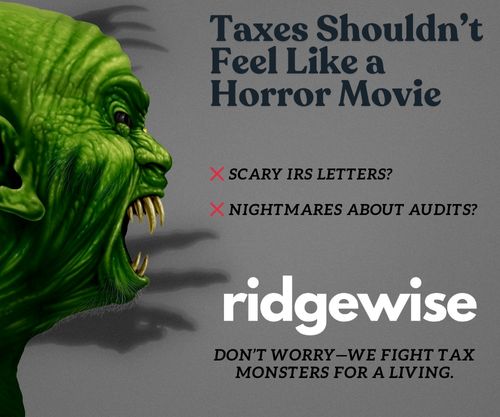With nearly 2 million partnerships and over 4 million S corporations registered in the U.S., understanding the differences between the 1065 and 1120S tax forms is crucial for business owners. Each form serves a unique purpose, impacting how your business is taxed and how income is reported. The 1065 form is designed for partnerships, while the 1120S caters to S corporations, making it essential to choose the right one for your entity type.
Ridgewise accounting specializes in guiding you through these complexities, ensuring you meet all tax obligations accurately. With a team experienced in both 1065 and 1120S filings, we provide tailored support that keeps your business compliant and financially healthy. Many businesses overlook the nuances between these forms, leading to potential pitfalls. Ridgewise stands out by offering personalized advice that aligns with your specific needs, helping you navigate these tax requirements with confidence. Understanding these forms is essential for your business’s success.
Overview of 1065 and 1120S
Understanding the 1065 and 1120S tax forms is essential for business owners in the U.S. Each form serves a specific purpose and caters to different business structures, impacting how income is reported and taxed.
Key Differences Between 1065 and 1120S
The primary difference lies in the type of business entity that files each form. The 1065 form is designed for partnerships and reports the income, deductions, gains, and losses of the partnership. It requires all partners to report their share of the income on their personal tax returns.
In contrast, the 1120S form is for S corporations. It reports the income, deductions, and credits of the S corporation and passes through income to shareholders, which they report on their individual tax returns. Unlike partnerships, S corporations provide limited liability protection to their shareholders.
Purpose of Each Tax Form
The 1065 form is used to report the financial activity of a partnership. It details the partnership’s income and expenses, ensuring each partner accurately reflects their share of profit or loss.
The 1120S form serves to notify the IRS of an S corporation’s financial activities. By filing this form, an S corporation emphasizes its eligibility for pass-through taxation, meaning the income is not taxed at the corporate level.
Ridgewise Accounting understands the nuances between these tax forms and supports businesses in proper filing and compliance. Our bookkeeping services ensure accurate record-keeping, helping you avoid potential tax issues and penalties.
Filing Requirements
Filing requirements differ between the 1065 and 1120S forms and serve specific needs for each entity type.
Eligibility for 1065
Partnerships file Form 1065 if they consist of two or more partners who engage in business activities. These partners can be individuals, corporations, or other partnerships, and they share profits and losses according to the partnership agreement. To file correctly, partnerships must report all income, deductions, gains, and losses, distributing this information to partners through Schedule K-1. Partners then use this data on their personal tax returns. This form ensures accurate tracking of all financial activities within the partnership.
Ridgewise Accounting helps partnerships maintain organized records and prepare accurate Form 1065 submissions to meet all IRS requirements. Our bookkeeping services ensure proper documentation and provide guidance at every step.
Eligibility for 1120S
S corporations file Form 1120S when they meet specific qualifications. To qualify, the corporation must have no more than 100 eligible shareholders, all of whom must be U.S. citizens or residents. The corporation must also be a domestic entity and not an ineligible corporation, such as financial institutions or insurance companies. S corporations must report income, gains, losses, deductions, and credits while allowing income to flow through to shareholders for reporting on their individual tax returns.
Ridgewise Accounting assists S corporations in understanding their filing obligations and maintaining compliance with these specific eligibility criteria. Our bookkeeping services streamline record-keeping practices, ensuring accurate financial management and simplifying Form 1120S preparation.
Tax Implications
Understanding tax implications for partnerships and S corporations is crucial for accurate reporting and compliance. Each business entity type faces different treatment regarding taxation, impacting overall financial strategy.
Tax Treatment of Partnerships
Partnerships commonly file Form 1065, which reports income, deductions, gains, and losses. Income does not get taxed at the partnership level; instead, it passes through to partners. Each partner reports his or her share on personal tax returns through Schedule K-1. This approach provides flexibility in allocating income and losses per the partnership agreement.
Ridgewise Accounting offers guidance for partnerships in maintaining organized records and preparing Form 1065 accurately. Their bookkeeping services help prevent issues with the IRS and ensure partners meet all reporting obligations.
Tax Treatment of S Corporations
S corporations file Form 1120S, allowing income to pass through to shareholders. This structure prevents double taxation; however, S corporations must adhere to strict eligibility requirements, including having no more than 100 shareholders. Shareholders report their share of income on individual tax returns. This structure provides limited liability protection while permitting tax benefits.
Ridgewise Accounting supports S corporations in meeting compliance standards and managing financial records. Their bookkeeping services help maintain accurate reporting and compliance with eligibility criteria, ensuring smooth financial operations.
Advantages and Disadvantages
Understanding the advantages and disadvantages of Forms 1065 and 1120S aids in determining the best tax reporting method for your business.
Benefits of Filing 1065
Filing Form 1065 offers several advantages for partnerships:
- Avoids Taxation at the Partnership Level: Partnerships don’t pay taxes as an entity. Income passes through to partners, who report it on their individual tax returns.
- Flexible Profit Sharing: Partnerships can structure profit sharing according to their agreement, allowing for more customized financial arrangements.
- Simplicity in Filing: Form 1065 requires straightforward reporting of partnered income and expenses, simplifying the process for most small businesses.
- Loss Deduction: Partners can deduct losses on their individual returns, potentially offsetting other sources of income, which may result in tax savings.
Ridgewise helps partnerships manage Form 1065 by ensuring accurate record-keeping and compliance with IRS requirements, minimizing errors during the filing process.
Benefits of Filing 1120S
Filing Form 1120S provides distinct benefits for S corporations:
- Pass-Through Taxation: Like partnerships, S corporations pass income directly to shareholders, avoiding double taxation on corporate income.
- Limited Liability Protection: Shareholders enjoy limited liability, protecting personal assets from business debts and liabilities.
- Potential Tax Savings: S corporations may benefit from tax deductions on certain types of fringe benefits that are not available for partnerships.
- Credibility: Choosing S corporation status may enhance your business’s credibility, attracting investors and improving relationships with suppliers.
Ridgewise supports S corporations in navigating the nuances of Form 1120S, ensuring compliance with filing requirements and keeping financial records organized for accurate reporting.
Drawbacks of Each Form
While both forms have benefits, there are drawbacks associated with each:
- Complexity for Form 1065: Partnerships face challenges in tracking member allocations and providing Schedule K-1s, which can complicate the reporting process.
- Self-Employment Taxes: Partners may be subject to self-employment taxes on their share of the income, which could raise overall tax liability.
- Strict Eligibility for Form 1120S: S corporations must meet specific requirements, including sharing limitations, or they risk losing their status.
- Additional Formalities: S corporations have more formalities to adhere to, such as maintaining corporate minutes and conducting meetings, adding to administrative workload.
Ridgewise offers bookkeeping services to simplify the complexities of both forms. By providing tailored record-keeping solutions and personalized support, Ridgewise helps businesses navigate the tax landscape effectively.
Key Takeaways
- Understanding Tax Forms: The 1065 form is designed for partnerships, while the 1120S form is used by S corporations, each serving distinct tax purposes.
- Filing Requirements: Partnerships with two or more partners must file Form 1065, whereas S corporations, limited to 100 eligible shareholders, file Form 1120S.
- Tax Implications: Partnerships pass income through to partners, while S corporations allow shareholders to report income directly on personal returns, avoiding double taxation.
- Benefits and Drawbacks: Form 1065 offers flexibility in profit sharing but may involve complexities in tracking allocations, while Form 1120S provides limited liability but requires stricter eligibility criteria.
- Professional Support: Ridgewise Accounting specializes in helping businesses navigate the complexities of both tax forms, ensuring compliance and accurate financial reporting.
Conclusion
Understanding the differences between Form 1065 and Form 1120S is crucial for your business’s financial strategy. Each form serves distinct purposes and has unique implications for taxation and compliance. Whether you operate as a partnership or an S corporation, knowing which form to file can save you time and money.
By leveraging the expertise of professionals like Ridgewise Accounting, you can navigate the complexities of these tax forms with confidence. Their support ensures you meet all filing requirements while optimizing your financial management. Making informed decisions about your tax reporting will ultimately contribute to your business’s success and growth.
Frequently Asked Questions
What is Form 1065 used for?
Form 1065 is used by partnerships in the U.S. to report their income, deductions, gains, and losses. It requires partnerships to report all financial activities and for each partner to report their share on personal tax returns via Schedule K-1.
What is Form 1120S used for?
Form 1120S is used by S corporations in the U.S. to report similar financial activities as partnerships but permits income to pass through to shareholders. Shareholders report their shares on individual tax returns, benefiting from limited liability protection.
What are the filing requirements for Form 1065?
Partnerships with two or more partners who share profits and losses must file Form 1065. They must report their financial activities through Schedule K-1, ensuring that each partner’s income is accurately reflected on their personal tax returns.
What are the filing requirements for Form 1120S?
S corporations must file Form 1120S if they have no more than 100 eligible shareholders, all of whom must be U.S. citizens or residents. The form reports the corporation’s income, allowing for pass-through taxation to shareholders.
What are the tax implications of Form 1065?
Filing Form 1065 allows partnerships to avoid taxation at the partnership level. Instead, income passes through to partners, who report it on their individual tax returns using Schedule K-1, which can be beneficial for tax planning.
What are the tax implications of Form 1120S?
Form 1120S allows S corporations to enjoy pass-through taxation, meaning income is taxed only at the shareholder level. This prevents double taxation, but S corporations must meet specific eligibility criteria to retain their status.
What are the advantages of Form 1065?
Form 1065 offers several advantages, including avoiding partnership-level taxation, flexible profit sharing, relative simplicity in filing, and the ability for partners to deduct losses on their individual tax returns.
What are the disadvantages of Form 1065?
Disadvantages of Form 1065 include the complexity of tracking member allocations and potential self-employment taxes on partners’ shares of income. These factors can complicate financial management for partnerships.
What are the advantages of Form 1120S?
Advantages of Form 1120S include pass-through taxation, limited liability protection for shareholders, potential tax savings on fringe benefits, and improved business credibility which can help in securing funding or partnerships.
What are the disadvantages of Form 1120S?
Disadvantages of Form 1120S include strict eligibility requirements and additional formalities, which can lead to increased administrative work. These factors may be burdensome for smaller S corporations or new startups.
Related posts:
- The Ultimate Guide to Understanding Your Cash Flow Statement for Business Success
- Maximize Your Savings: Essential Small Business Tax Deductions You Can’t Afford to Miss
- Debit vs Credit: Understanding the Key Differences for Better Financial Management
- Understanding Liabilities in Accounting: Key to Financial Health for Your Business




